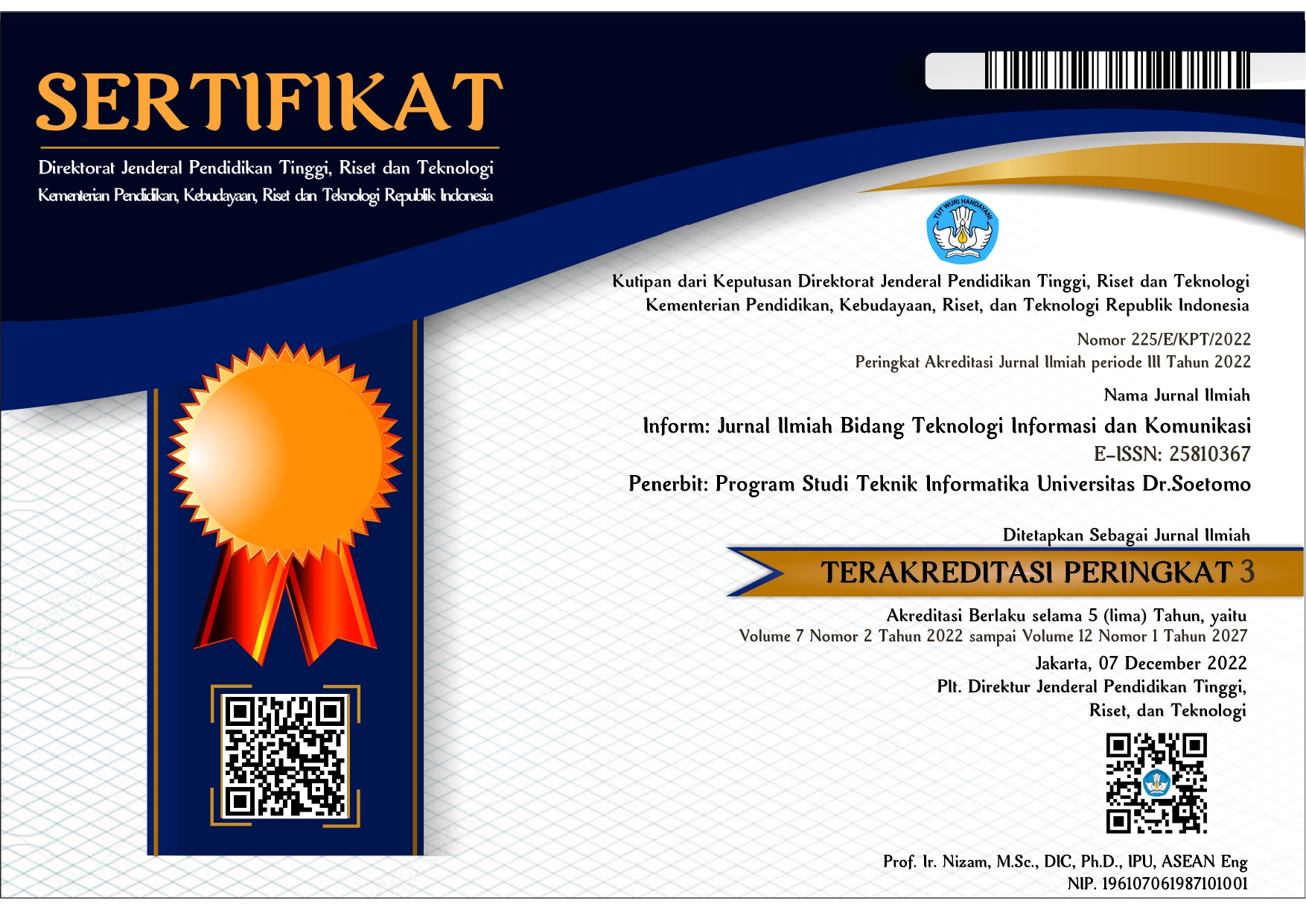Pengenalan Jenis Buah pada Citra Menggunakan Pendekatan Klasifikasi Berdasarkan Fitur Warna Lab dan Tekstur Co- Occurrence
 Abstract views: 938
,
Abstract views: 938
,
 PDF downloads: 2084
PDF downloads: 2084
Abstract
Abstract — Fruit recognition can be automatically applied to the field of education, industry, sales, as well as science. In the vision of computer recognition of fruit relies on four basic features that describe the characteristics of the fruit, i.e., size, color, shape, and texture. The fruit recognition through the RGB image results of cameras using the features of shape and size are not reliable and effective, because in a real data image can be composed of several different sizes of fruit on each type of fruit so it can't be identified morphologically the fruit size and uniformity that can affect the results of the classification. This journal based on the feature recognition method of building colors and textures for the classification of fruit.The classification is done by K-Nearest Neighbor based on color and texture features co-occurrence. Experimental results of 1882 dataset image of fruit for 12 different classes can recognize the fruit in both color and texture features based with the highest accuracy of 92%.
References
classification from images”. Computers and Elec-tronics in
Agriculture 70 (2010) 96–104
[2] S.Arivazhagan, et al. 2010. “Fruit Recognition using Color and
Texture Features”. CIS journal: Journal of Emerging Trends in
Computing and InformationSciences
[3] Zhang, Yudong dan Lenan Wu. 2012. “Classification of Fruits
Using Computer Vision and a Multiclass Support Vector
Machine”. sensors 12.9 (2012): 12489-12505.
[4] Faria, Fabio Augusto, et al. "Automatic Classifier Fusion for
Produce Recognition." Graphics, Patterns and Im-ages
(SIBGRAPI), 2012 25th SIBGRAPI Conference on. IEEE, 2012.
[5] Seng, W. C., & Mirisaee, S. H. 2009. “A new method for fruits
recognition system”. Electrical Engineering and Informatics,
2009. ICEEI'09. International Conference on (Vol. 1, pp. 130-
134). IEEE.
[6] Mendoza, F., Dejmek, P., & Aguilera, J. M. 2006. “Calibrated
color measurements of agricultural foods using image analysis”.
Postharvest Biology and Technology, 41(3), 285-295.
[7] Tam, W. K., & Lee, H. J. 2012. “Dental shade matching using a
digital camera”. Journal of Dentistry, 40, e3-e10.
[8] Busin, L., Vandenbroucke, N., & Macaire, L. (2008). “Color
spaces and image segmentation”. Advances in im-aging and
electron physics, 151, 65-168.
[9] Cardani, D. (2001). “Adventures in HSV space”. Vision and
Image Sciences Laboratory Department of Electri-cal
Engineering Technion - Institute of Technology 32000 Haifa
Israel.
[10] Kadir, A., Nugroho, L. E., Susanto, A., & Santosa, P. I. (Agustus
2011). Leaf classification using shape, color, and texture
features. International Journal of Computer Trends and
Technology, 225-230.
[11] Reddy, R. Obula Konda, dkk. (2013). “Classifying Similarity
and Defect Fabric Textures based on GLCM and Binary Pattern
Schemes”. I.J. Information Engineering and Electronic Business
5:25-33
Copyright (c) 2016 Evy Kamilah Ratnasari

This work is licensed under a Creative Commons Attribution-ShareAlike 4.0 International License.
Authors who publish with Inform: Jurnal Ilmiah Bidang Teknologi Informasi dan Komunikasi agree to the following terms:
-
Authors retain copyright and grant the journal right of first publication with the work simultaneously licensed under a Creative Commons Attribution License (CC BY-SA 4.0) that allows others to share the work with an acknowledgment of the work's authorship and initial publication in this journal.
-
Authors are able to enter into separate, additional contractual arrangements for the non-exclusive distribution of the journal's published version of the work (e.g., post it to an institutional repository or publish it in a book), with an acknowledgment of its initial publication in this journal.
-
Authors are permitted and encouraged to post their work online (e.g., in institutional repositories or on their website) prior to and during the submission process, as it can lead to productive exchanges, as well as earlier and greater citation of published work.












